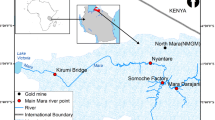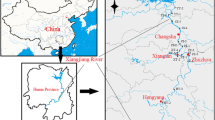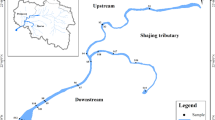Abstract
The spatial–temporal changing characteristics and potential ecological risk combined with local policies and industrial status were analyzed. The metal contamination was studied by sediment quality guidelines (SQGs), potential ecological risk index (PERI), and geoaccumulation index (I geo) of metals (Hg, Cr, Cd, As, Pb, and Cu) in the sediments of Xiaoqing River in Jinan from 1996 to 2014. Results showed that the concentrations of metals were in fluctuation and had a decreasing trend in the past 19 years, which was influenced by industry and policy. The concentrations of metals from upstream to downstream presented a change from low to high and then a gradual decrease which were mainly related to anthropogenic activities. The assessment suggested that Hg presented the highest levels of I geo and was the largest contributor to RI, while Cd was the second contributor. This finding indicated that Hg and Cd had a strong effect on potential ecological risk. Damatou had the largest pollution level and potential ecological risk, whereas Mulizhuang was the least polluted area. SQGs indicated that Cd was below the TEC while it was the second contributor to potential ecological risk. Indeed, the pollution control of Xiaoqing River had a certain effect, but it needs long-term effective management measures and a strengthened source control. The suggestions of targeted management have been proposed in the paper.






Similar content being viewed by others
References
Bakker K (2012) Water security: research challenges and opportunities. Science 337(6097):914–915
Bert V, Seuntjens P, Dejonghe W, Lacherez S, Thuy HTT, Vandecasteele B (2009) Phytoremediation as a management option for contaminated sediments in tidal marshes, flood control areas and dredged sediment landfill sites. Environ Sci Pollut Res 16:745–764
Bhuiyan MAH, Dampare SB, Islam MA, Suzuki S (2014) Source apportionment and pollution evaluation of heavy metals in water and sediments of Buriganga River, Bangladesh, using multivariate analysis and pollution evaluation indices. Environ Monit Assess 187:4075
Brayner FMM, da Silva HKP, Barbosa AMF (2001) Speciation of heavy metals in estuarine sediments in the northeast of Brazil. Environ Sci Pollut Res 8:269–274
Chabukdhara M, Nema AK (2012) Assessment of heavy metal contamination in Hindon River sediments: a chemometric and geochemical approach. Chemosphere 87:945–953
Chatterjee M, Silva Filho EV, Sarkar SK, Sella SM, Bhattacharya A, Satpathy KK, Prasad MVR, Chakraborty S, Bhattacharya BD (2007) Distribution and possible source of trace elements in the sediment cores of a tropical macrotidal estuary and their ecotoxicological significance. Environ Int 33:346–356
Chinese Ministry of Environmental Protection (1990) China background values of soil element. China Environmental Science Press GB3838-2002, Beijing (in Chinese)
Franklin RL, Silva SA, Fávaro DIT, Luiz-Silva W (2016) Trace and some rare earth elements distribution in a sediment profile from Jurumirim Reservoir, São Paulo State, Brazil: total content and extracted phases. J Radioanal Nucl Chem 309:439–451
Fu J, Zhao C, Luo Y, Liu C, Kyzas GZ, Luo Y, Zhao D, An S, Zhu H (2014) Heavy metals in surface sediments of the Jialu River, China: their relations to environmental factors. J Hazard Mater 270:102–109
Gao X, Chen C-TA (2012) Heavy metal pollution status in surface sediments of the coastal Bohai Bay. Water Res 46:1901–1911
Hakanson L (1980) An ecological risk index for aquatic pollution control: a sedimentological approach. Water Res 14:975–1001
Hu B, Li G, Li J, Bi J, Zhao J, Bu R (2013) Spatial distribution and ecotoxicological risk assessment of heavy metals in surface sediments of the southern Bohai Bay, China. Environ Sci Pollut Res 20:4099–4110
Huang Y, Li YX, Gao FW, Xu MM, Sun B, Wang N, Yang J (2015) Speciation and risk assessment of heavy metals in surface sediments from the heavily polluted area of Xiaoqing River. Environ Sci 36(6):2046–2053 (in Chinese)
Huh IA, Kim YS, Yu SJ, Wong S, Shin WS, Park HO et al (2014) Development of freshwater sediment management standards for organic matters, nutrients, and metals in korea. Environ Sci Pollut Res 21:86–94
Idris AM (2008) Combining multivariate analysis and geochemical approaches for assessing heavy metal level in sediments from Sudanese harbors along the Red Sea coast. Microchem J 90:159–163
Jia Y, Fang M, Wu YJ, Liu H, Miu Y, Wang XT, Lin WX, Tong X (2013) Pollution characteristics and potential ecological risk of heavy metals in river sediments of Shanghai. China Environ Sci 33(1):147–153 (in Chinese)
Jiao GL, Wang LP, Zu J, Huang LY (2011) The water quality assessment and pollution source analysis in the Xiaoqing River. Zhi Huai 12:86–87 (in Chinese)
Jinan Environmental Quality Reports (1996–2014) The Environmental Protection Bureau of Jinan (in Chinese)
Jinan Statistical Yearbooks (1996–2014) The Statistical Bureau of Jinan (in Chinese)
Keshavarzi B, Mokhtarzadeh Z, Moore F, Rastegari Mehr M, Lahijanzadeh A, Rostami S, Kaabi H (2015) Heavy metals and polycyclic aromatic hydrocarbons in surface sediments of Karoon River, Khuzestan Province, Iran. Environ Sci Pollut Res 22:19077–19092
Kim DS, Mizuno K, Kobayashi S (2003) Analysis of urbanization characteristics causing farmland loss in a rapid growth area using GIS and RS. Paddy Water Environ 1:189–199
Lei P, Zhang H, Shan B, Lv S, Tang W (2016) Heavy metals in estuarine surface sediments of the Hai River Basin, variation characteristics, chemical speciation and ecological risk. Environ Sci Pollut Res 23:7869–7879
Lin Q, Liu E, Zhang E, Li K, Shen J (2016) Spatial distribution, contamination and ecological risk assessment of heavy metals in surface sediments of Erhai Lake, a large eutrophic plateau lake in southwest China. Catena 145:193–203
Macdonald DD, Ingersoll CG, Berger TA (2000) Development and evaluation of consensus-based sediment quality guidelines for freshwater ecosystems. Arch Environ Contam Toxicol 39(1):20–31
Mei ZB, Xu ZH, Xia Q (2011) Water environmental protection and research in Jinan reach of the Xiaoqing River. Shandong Water Conservancy 11:59–60 (in Chinese)
Muller G (1969) Index of geoaccumulation in sediments of the Rhine River. Geo 2:108–118
Mwanamoki PM, Devarajan N, Niane B, Ngelinkoto P, Thevenon F, Nlandu JW, Mpiana PT, Prabakar K, Mubedi JI, Kabele CG, Wildi W, Poté J (2015) Trace metal distributions in the sediments from river-reservoir systems: case of the Congo River and Lake Ma Vallée, Kinshasa (Democratic Republic of Congo). Environ Sci Pollut Res 22:586–597
Olivares-Rieumont S, de la Rosa D, Lima L, Graham DW, D’Alessandro K, Borroto J, Martínez F, Sánchez J (2005) Assessment of heavy metal levels in Almendares River sediments—Havana City, Cuba. Water Res 39:3945–3953
Peng ST, Hu YD, Bai ZP (2009) Pollution assessment and ecological risk evaluation for heavy metals in the sediments of Bohai Bay. Waterway and Harbor 30(1):57–60 (in Chinese)
Ribeiro AP, Figueira RCL, Martins CC, Silva CRA, França EJ, Bícego MC, Mahiques MM, Montone RC (2011) Arsenic and trace metal contents in sediment profiles from the Admiralty Bay, King George Island, Antarctica. Mar Pollut Bull 62:192–196
Sakan S, Gržetić I, Đorđević D (2007) Distribution and fractionation of metals in the Tisa (Tisza) River sediments. Environ Sci Pollut Res - Int 14:229–236
Shi Y, Vestergren R, Xu L, Song X, Niu X, Zhang C, Cai Y (2015) Characterizing direct emissions of perfluoroalkyl substances from ongoing fluoropolymer production sources: a spatial trend study of Xiaoqing River, China. Environ Pollut 206:104–112
Shikazono N, Tatewaki K, Mohiuddin KM, Nakano T, Zakir HM (2012) Sources, spatial variation, and speciation of heavy metals in sediments of the Tamagawa River in Central Japan. Environ Geochem Health 34:13–26
Statistics Bulletin of the National Economic and Social Development of Jinan (2015) The Statistical Bureau of Jinan (in Chinese)
Sun B, Huang Y, Li YX, Xu MM, Gao FW, Yang J, Wang N (2016) Assessment model of heavy metal pollution for sediments based on principal component analysis. Environ Sci Technol 39:175–184 (in Chinese)
Tang D, Warnken KW, Santschi PH (2002) Distribution and partitioning of trace metals (Cd, Cu, Ni, Pb, Zn) in Galveston Bay waters. Mar Chem 78:29–45
Taylor SR, McLennan SM (1995) The geochemical evolution of the continental crust. Rev Geophys 33:293–301
Tessier E, Garnier C, Mullot J-U, Lenoble V, Arnaud M, Raynaud M, Mounier S (2011) Study of the spatial and historical distribution of sediment inorganic contamination in the Toulon bay (France). Mar Pollut Bull 62:2075–2086
Tian JY, Mu JB, Wang AD et al (1996) Study of water pollution problems and water quality management in the Xiaoqing River basin of Shandong Province. Petroleum University Press, Dongying (in Chinese)
Varol M (2011) Assessment of heavy metal contamination in sediments of the Tigris River (Turkey) using pollution indices and multivariate statistical techniques. J Hazard Mater 195:355–364
Venkatramanan S, Ramkumar T, Anithamary I, Vasudevan S (2014) Heavy metal distribution in surface sediments of the Tirumalairajan river estuary and the surrounding coastal area, east coast of India. Arab J Geosci 7:123–130
Vorosmarty CJ, McIntyre PB, Gessner MO, Dudgeon D, Prusevich A, Green P, Glidden S, Bunn SE, Sullivan CA, Liermann CR, Davies PM (2010) Global threats to human water security and river biodiversity. Nature 467:555–561
Wang C, Xia XQ, Zhao XQ, Zheng WJ, Zheng WJ, Zhou GH, Hu XP, Ji SP (2012) Distribution and migration regularity of soil heavy metal pollution along the Xiaoqing watershed, Shandong Province. Geol China 39(2):530–538 (in Chinese)
Wang L, Wang Y, Zhang W, Xu C, An Z (2014) Multivariate statistical techniques for evaluating and identifying the environmental significance of heavy metal contamination in sediments of the Yangtze River, China. Environ Earth Sci 71:1183–1193
Wang P, Lu Y, Wang T, Meng J, Li Q, Zhu Z, Sun Y, Wang R, Giesy JP (2016) Shifts in production of perfluoroalkyl acids affect emissions and concentrations in the environment of the Xiaoqing River Basin, China. J Hazard Mater 307:55–63
Wei X, Han L, Gao B, Zhou H, Lu J, Wan X (2016) Distribution, bioavailability, and potential risk assessment of the metals in tributary sediments of Three Gorges Reservoir: the impact of water impoundment. Ecol Indic 61(Part 2):667–675
Xu G, Liu J, Pei S, Hu G, Kong X (2015) Geochemical background and ecological risk of heavy metals in surface sediments from the west Zhoushan Fishing Ground of East China Sea. Environ Sci Pollut Res 22:20283–20294
Yang Y, Jin Q, Fang JM, Liu FQ, Li AM, Tandon P, Shan A (2017) Spatial distribution, ecological risk assessment, and potential sources of heavy metal(loid)s in surface sediments from the huai river within the bengbu section, China. Environ Sci Pollut Res 1–11
Yi YJ, Sun J, Tang CH, Zhang SH (2016) Ecological risk assessment of heavy metals in sediment in the upper reach of the Yangtze River. Environ Sci Pollut Res 23:11002–11013
Yu S, Xu Z, Liu X, Dou T, Xu C (2015) Identifying and validating freshwater ecoregions in Jinan City, China. J Hydrol 528:763–772
Zhang GQ, Wang ZJ (2010) Heavy metals pollution risk assessment in surface water sediments of Jinan. Environ Sustain Dev 5:40–44 (in Chinese)
Zhang ZR, Lu BQ, Wang FD (2012) The comprehensive governance effect evaluation and countermeasures research in Xiaoqing River. Shandong Science and Technology Press, Jinan (in Chinese)
Zohra BS, Habib A (2016) Assessment of heavy metal contamination levels and toxicity in sediments and fishes from the Mediterranean Sea (southern coast of Sfax, Tunisia). Environ Sci Pollut Res 23:13954–13963
Acknowledgements
We thank the anonymous reviewers for their insight and critical review of the manuscript. We also thank Jacob Teter and the professional institution (ShineWrite.com) for the language review. This work was supported by National Natural Science Foundation of China (No. 41301649).
Author information
Authors and Affiliations
Corresponding author
Additional information
Responsible editor: Severine Le Faucheur
Electronic supplementary material
ESM 1
(DOCX 24 kb)
Rights and permissions
About this article
Cite this article
Jiao, F., Ren, L., Wang, X. et al. Pollution characteristics and potential ecological risk assessment of metals in the sediments of Xiaoqing River, Jinan. Environ Sci Pollut Res 24, 15001–15011 (2017). https://doi.org/10.1007/s11356-017-9056-8
Received:
Accepted:
Published:
Issue Date:
DOI: https://doi.org/10.1007/s11356-017-9056-8




